The concept of a “rising” fastball has swept across the league over the last few seasons. The Rays and Astros started attacking the top of the zone with high spin, high-velocity four-seam fastballs and the rest of the league has mostly followed suit.
Of course, there is a lot more that goes into understanding why a fastball can be successful than having a lot of ride and velocity. Alex Chamberlain gave an informative presentation at PitchCon about Vertical Approach Angle and has continued expanding on it at FanGraphs.
VAA can certainly tell us a lot about why certain pitches are successful in certain locations. It is just not something I am prepared (or smart enough) to talk on yet.
What I do know is that fastballs with more ride generally get more whiffs. Jeremy Siegel made this graph showing the relationship between fastball ride and fastball whiffs since 2019.
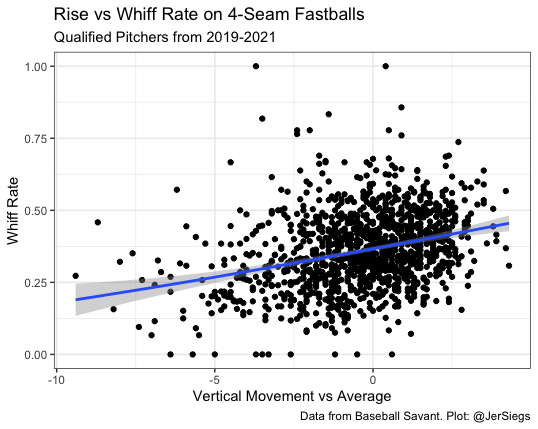
Rudimentary, not accounting for location or velocity, but the relationship is still non-zero. With this, I have identified four pitchers (three starters, one reliever) who have exception fastball ride. Each could make a big jump this season and should be targeted in your drafts!
Patiño was the centerpiece in the Rays’ return for Blake Snell and his first year in their organization went just OK. He threw 80 innings in the majors (129 IP across all levels) with a 4.31 ERA, 22.2% strikeout rate, and 8.7% walk rate. All in all, pretty good for a 21-year-old but just a taste of his tantalizing potential.
Patiño’s calling card has always been freakish athleticism. While not the biggest guy in the world at 6’1″ and 190 lbs, he is incredibly explosive. The ball simply fires out of his hand and that’s evident with his fastball.
https://gfycat.com/dampcolorfulbordercollie
That pitch looks like a fire-cracker. Patiño’s fastball had a 95.7 mph average velocity last season, 25th fastest among qualified pitchers. It also had the 18th most ride of any four-seamer, rising 2.2 inches more than the average. Despite these incredible traits, Patiño’s fastball had a very pedestrian 23.1% whiff rate.
Command was a serious issue for Patiño with the Padres in 2020 as he walked 18 of the 85 (16.5%) batters he faced. The walks became palatable last season, but command is more than just limiting free passes.
He is so young and freakishly athletic that it will likely be years before his mechanics are optimized and perfectly repeatable. Still, this means his fastballs are not always thrown in the most advantageous locations.
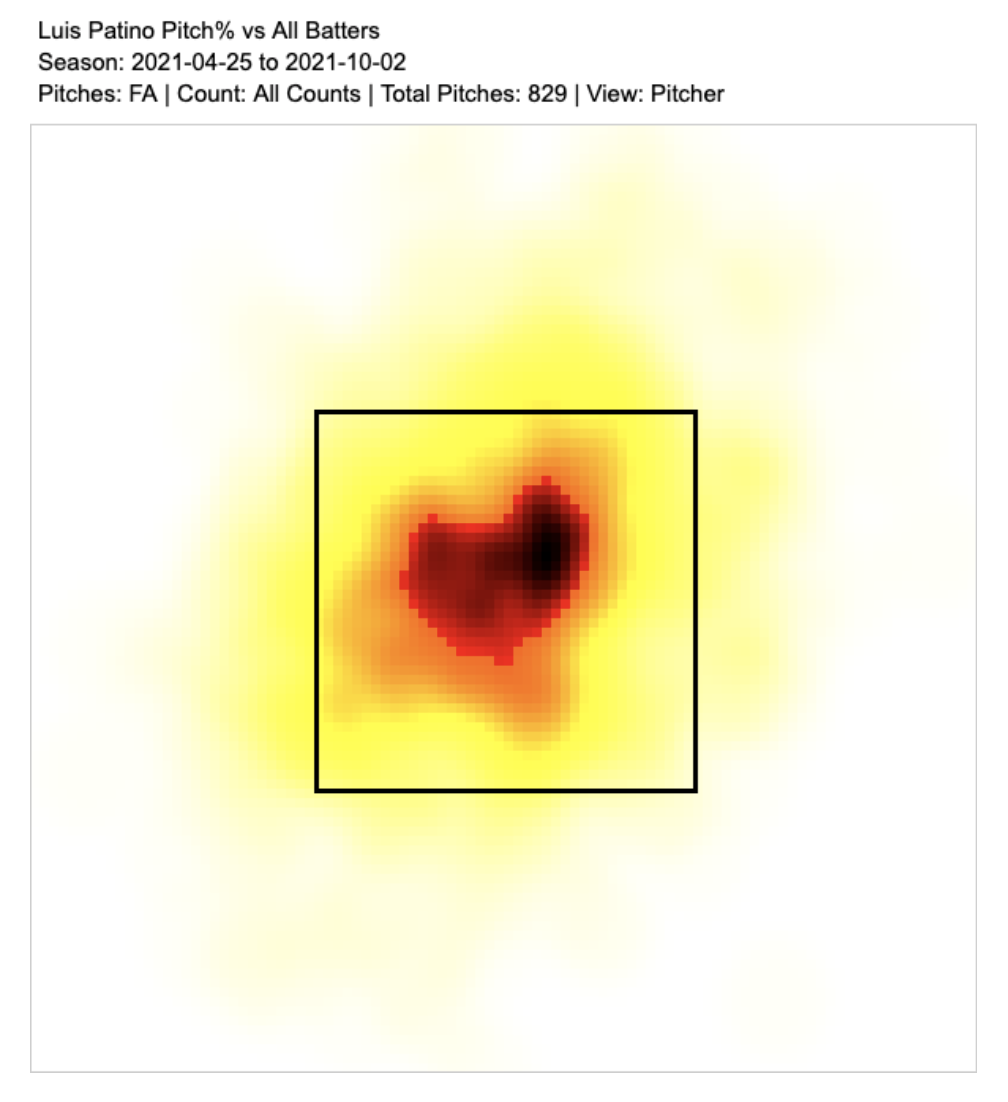
However, all those fastballs down the middle may be more tied to organizational philosophy than something Patiño is doing wrong. Former Driveline video editor Lance Brozdowski made a compelling YouTube video in December about the Rays providing a universal target for some of their more erratic pitchers.
He focused on Tyler Glasnow and Peter Fairbanks, but the tape shows Patiño being given something similar.
https://gfycat.com/somberselfishdonkey
The idea here is that pitchers are going to miss their target most of the time, especially young pitchers who throw lively fastballs. So, setting up in the middle of the plate means their misses are most likely to be either strikes or fastballs that leave the zone up. Patiño seemed to actually hit his target more often than not so it’s reasonable to expect better command next season.
Improvement there along with a devastating slider (and Rays bump) means Patiño can realistically jump to stardom in the near future.
Pitcher List has become something of a Means hype-blog. We have an inordinate amount of Orioles fans writing here which helps, but the talent is legit.
Means debuted with little prospect status in 2018 and has found consistent success since. He was able to evade 2019’s power surge (9.9 HR/FB%) en route to a 3.60 ERA in 155 IP… with the ORIOLES! On the other hand, his K% sat well below league-average and his ERA estimators (4.41 FIP, 5.48 xFIP) showed he benefited from plenty of good luck.
Regression hit in 2o2o. That HR/FB rate ballooned to 21.8% and his ERA wound up at 4.53. Those stats are over just 10 starts though, so they mean very little. More importantly, Means’ fastball gained two full ticks of velocity and he closed the year out with 21 strikeouts over his last 11.2 innings.
He started 2021 guns blazing and his hot start culminated with a 12 K no-hitter in Seattle. It seemed like the corner had finally been turned until a shoulder strain knocked him out for a month and hurt his production for the rest of the season.
The full-body of work shows an inconsistent pitcher, but Means’ stuff shows the potential for growth. His changeup has always been the calling card while both his slider and curveball have demonstrated an ability to miss bats. We are going to look at his fastball here, though.
Despite below-average velocity, the pitch gets well above average ride. It “rises” 2.6 inches more than the average, 14th best among all qualified pitchers. You can feel it getting on hitters without serious heat.
https://gfycat.com/warpedpaltryeastsiberianlaika
With that being said, Means’ fastball success has still largely been reliant on velocity. His fastball has always hovered between 92 and 94 mph. When 93 mph or faster, it has a 25% whiff rate. That number drops to 18.5% when slower than 93 mph.
Last season was a microcosm of this fact. While Means’s average fastball velocity was exactly the same before and after his shoulder strain (92.8 mph), pitchers will naturally pick up velocity as the season goes on peaking towards summer’s end. So, Means’s 92.8 was a hair above league-average in April and May while the same speed was below in July, August, and September.
It is likely Means’ shoulder strain impacted his second half. There’s a chance the sticky stuff ban did as well. Either can be true here and we have no way of knowing. However, I’m still buying into the potential here with his fastball, deep pitch-mix, and park adjustments at Camden Yards.
The prodigal son finally took his step forward the fantasy community had been waiting years for. Pivetta had a 26.4 K%, 9.9 BB%, and 4.56 ERA over 154 IP last year for the Red Sox. His volume was integral to their playoff push and there was an underlying skills jump that suggest he could be even better.
He made three relief appearances for the Phillies in 2o20 before being traded to Boston and making two starts. It was hard to glean anything meaningful at the time, but the fact that he had just 4 K in 5.2 IP with Philly versus 13 K in 10 IP with Boston was a signal.
So, let’s head back to 2019. He pitched a total of 93.2 innings with the Phillies across 13 starts and 17 relief appearances. Usually shifting a starter to the bullpen will allow their stuff to play up, and Pivetta’s did a bit.
His fastball jumped from 94.3 to 95.8 mph and dropped an inch and a half less (12.1 to 10.6). There was very little change to either his curveball or slider.
Last season, however, all three pitches had better movement profiles than at any point in 2019. His curveball had nearly five more inches of drop and his slider picked up an inch of horizontal movement while cutting a small amount of drop. Most importantly, his fastball picked up another half-inch of “rise” and lost almost all of its horizontal movement.
The differences in his fastball are clear on video. Its shape was completely different with much less arm side run and clear rising action.
https://gfycat.com/formalimaginarybee
It had the 25th most “rise” last season and 18% more than league average. This new shape allowed Pivetta to more effectively work in the top of the strike zone too, something he had not done very much in Philadelphia despite his plus velocity. Here are the locations of his fastball from 2018, 2019, and 2021 from left to right.
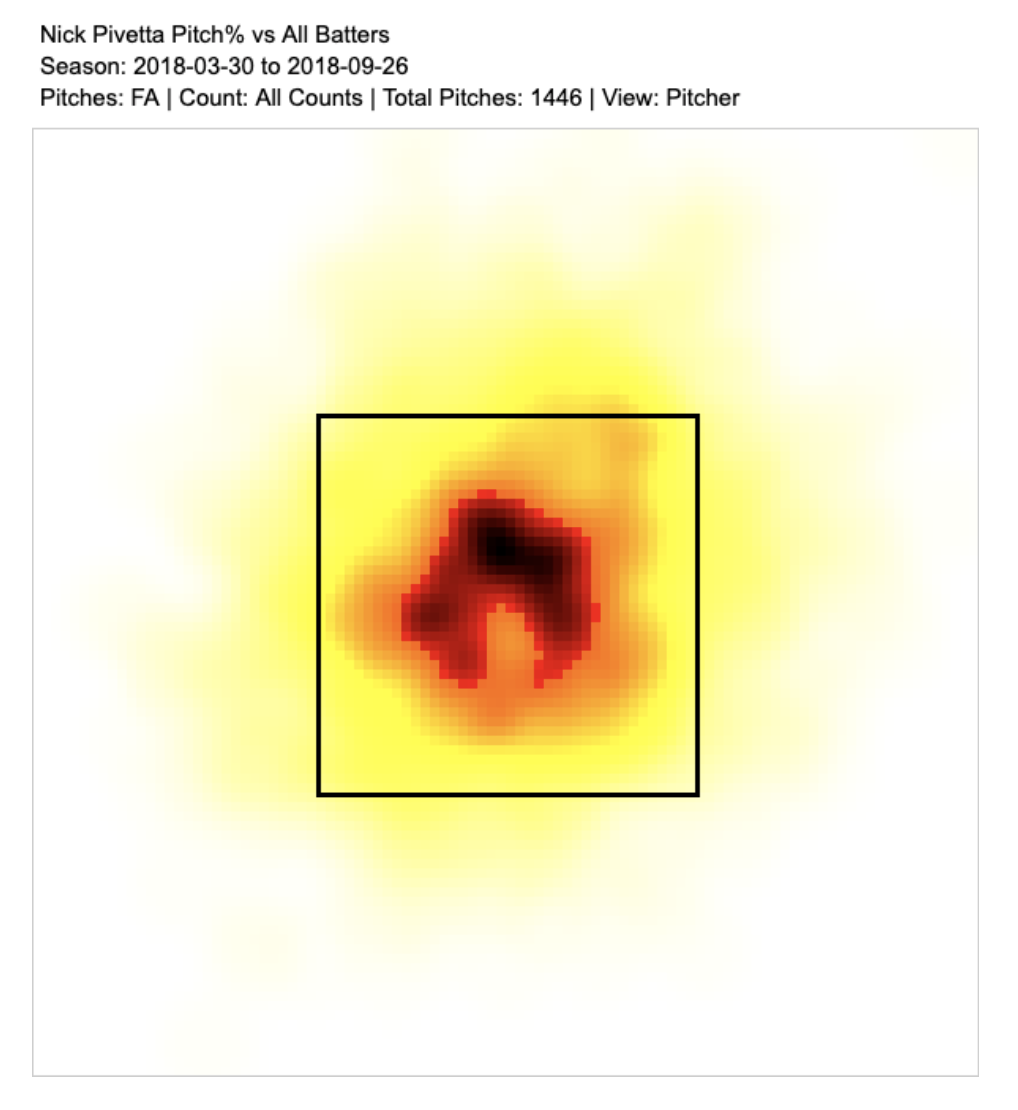

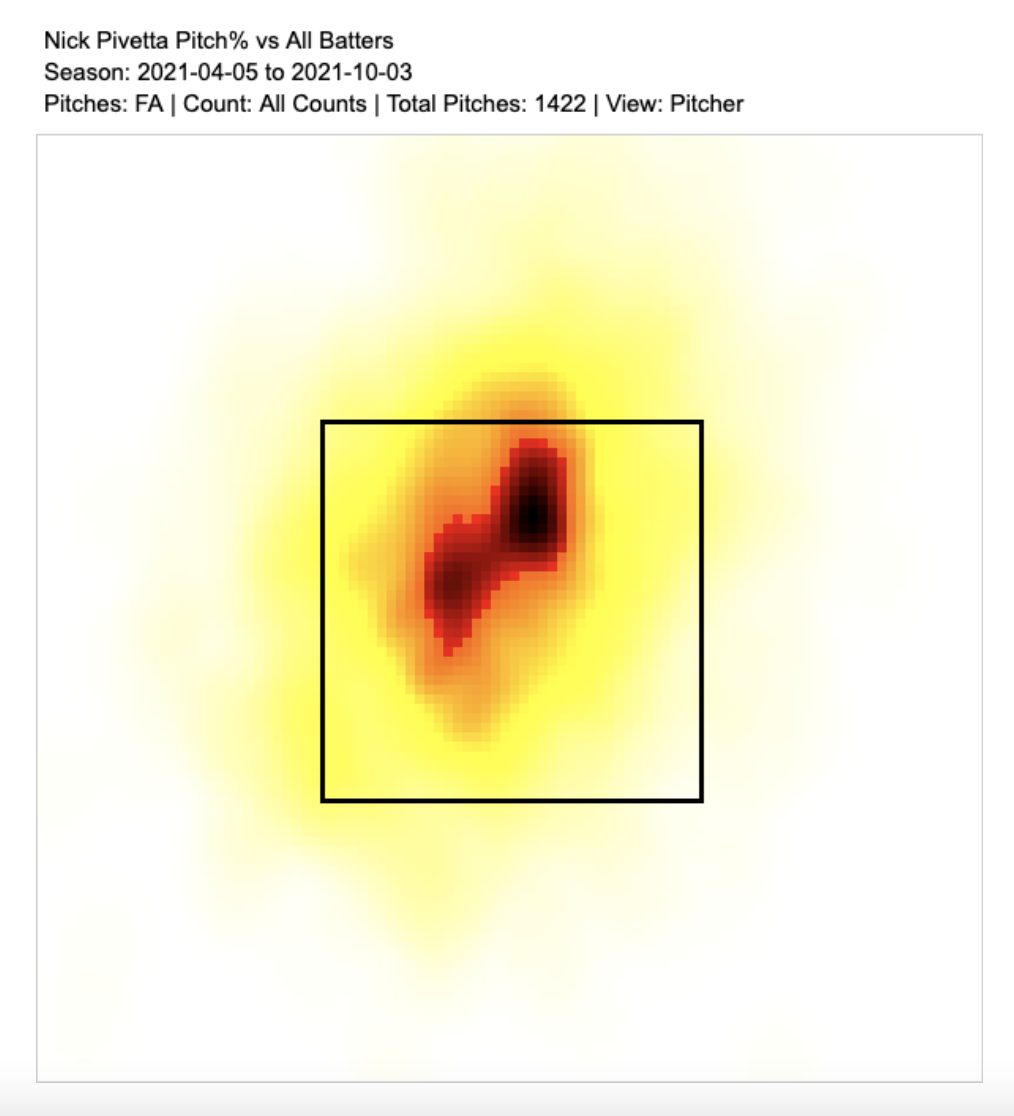
Using the top of the zone is especially important for Pivetta based on the shape of his curveball. It is a nearly straight up and down 12-6 breaker that perfectly mirrors his new fastball shape. Seriously, it perfectly mirrors it.

Bottom line, the Red Sox front office seems to have arranged a near-perfect repertoire for Pivetta tied together by his fastball adjustment. I am expecting him to build on his very successful 2021.
Our first and only reliever making it to the party! The assumed Rangers’ closer has come out of nowhere to have an ADP of 243.5 on NFC over the last month and a minimum pick of 135! Freaking closers, can’t live with them and can’t live without them.
That being said, Barlow is filthy and should not face much competition for the role. Spencer Patton, Josh Sborz, and Brett Martin all have significantly worse stuff than Barlow. José Leclerc and Jonathan Hernández are each closing in on a year since their Tommy John surgeries, but I doubt we see either pitch before May. So, Barlow has a window to secure the role.
Of course, the threat of Kenley Jansen or another high-priced reliever acquisition looms. That would completely up-end Barlow’s fantasy value despite a nasty arsenal.
Stuff can be very difficult to quantify, especially for a reliever with fewer than 500 major league pitches under his belt. Luckily Eno Sarris and his fantastic Stuff+ model make it easy. It ranks Barlow near relievers like Corey Knebel, Julian Merryweather, Jordan Hicks, and Enoli Paredes. That is a fantastic group in terms of stuff.
A big part of Barlow’s stellar stuff score is driven by his exceptional fastball. It is the quintessential modern fastball with little horizontal movement and plenty of rising action.
https://gfycat.com/plainpastgoa
The pitch looks explosive at just 95 mph. It “rises” 3.2 inches more than the average, ninth among all pitchers who threw at least 100 fastballs last season. Oddly enough, its whiff rate was just 17.9%.
That’s because Barlow’s fastball command was a bit erratic as a rookie. Its rising action makes it a perfect fit for the top of the zone, but it was thrown all over the place.
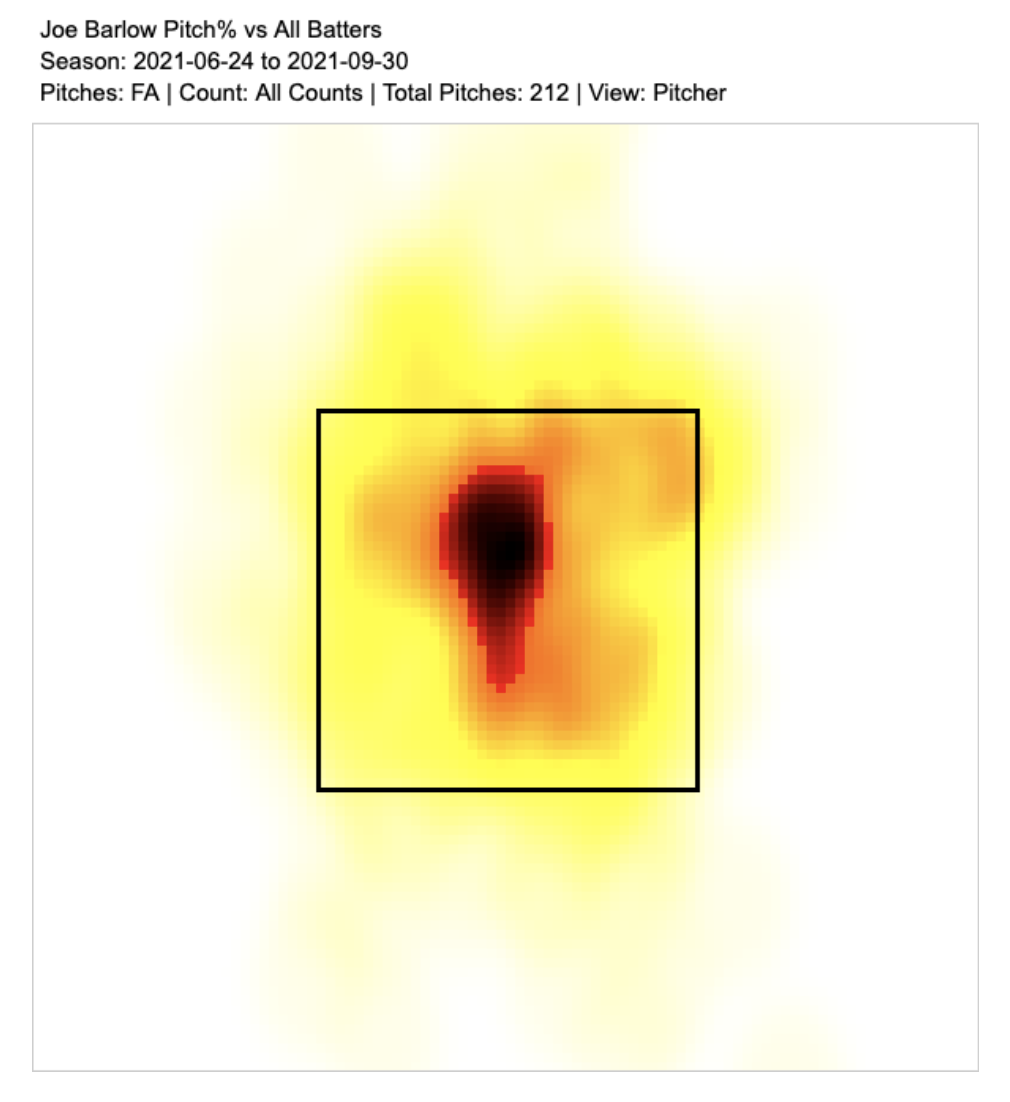
He is someone else that could benefit from a universal target approach. It seems like the Rangers gave him a semi-consistent target from watching his fastballs this season, it was just much lower in the zone than what we saw with Patiño above.
https://gfycat.com/uniformdizzyarrowworm
This impact is hard to determine right now and I hope to do more research on this moving forward. Otherwise, the foundation is there for Barlow’s fastball to be an impact pitch while his slider (35.4% whiff rate) and curveball (30.8% whiff rate) carry most of the water. He could be a diamond in the rough.
Photos by Icon Sportswire | Adapted by Justin Redler (@reldernitsuj on Twitter)

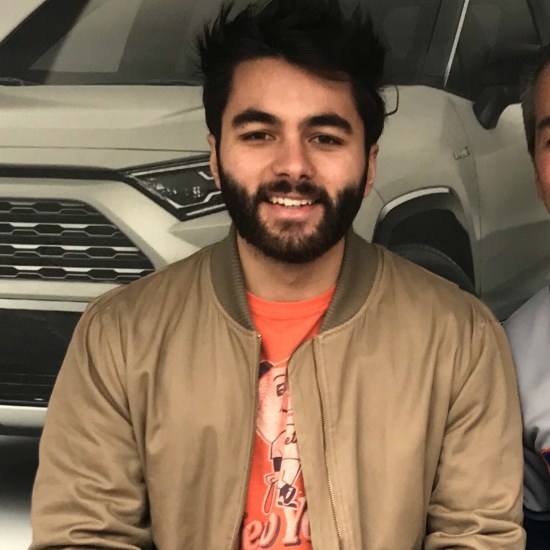
Interesting article. Thanks. Hello from a fellow Buckeye.
O-H!